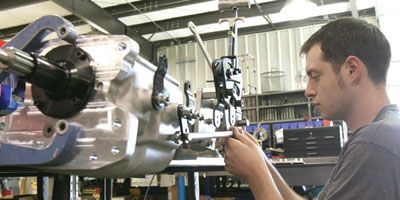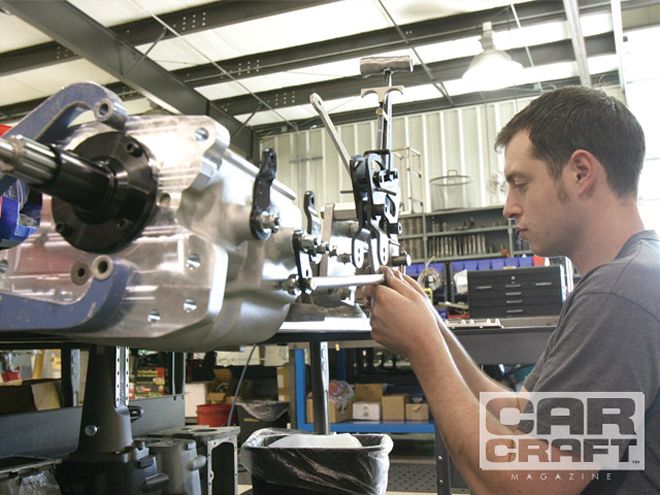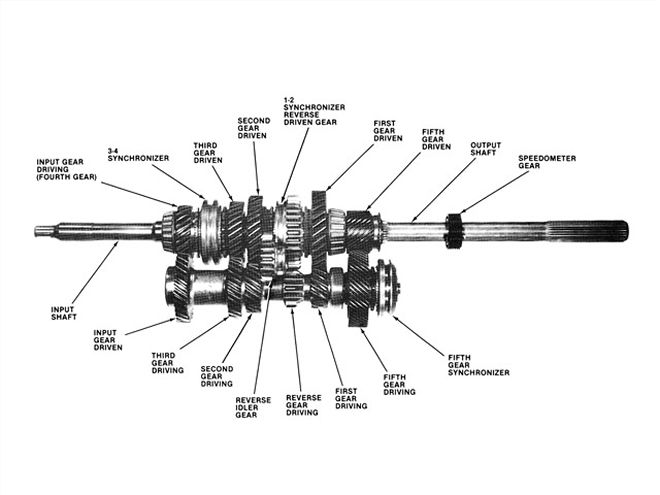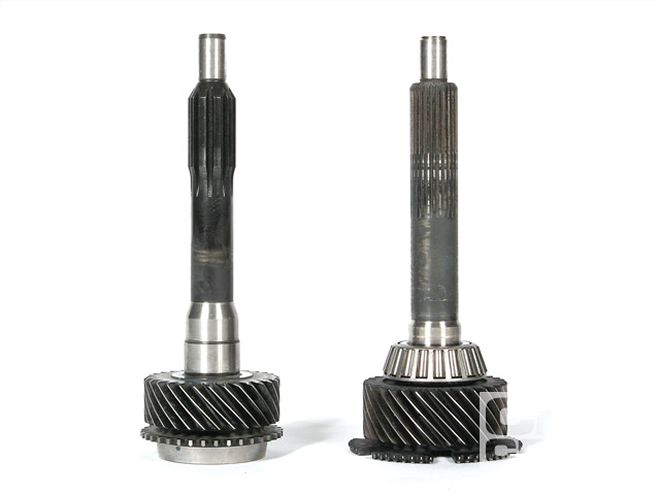
 Jerico's Dan Cordier puts the finishing touches on a DR-4 drag racing box.
Jerico's Dan Cordier puts the finishing touches on a DR-4 drag racing box.
Big horsepower numbers are easy to come by. We no longer have to dream of someday building a 500hp engine. The reality is you can build one easily and relatively cheaply. But as the old saw goes, what good is all that power if you can't put it to the ground? Fortunately, the rest of the industry has kept up with the engine builders. Clutch material and design have improved, and tire compounds are way better today than even 10 years ago. Transmissions have seen great improvements, too. This article will illustrate some of the ways manual transmission builders have kept up with ever-increasing horsepower numbers.

How It Works
We should begin with the basics just to get everyone up to speed. Virtually every modern manual transmission consists of three shafts inside its case: the input shaft, the mainshaft, and the countershaft. The input shaft extends through the front of the case and engages the clutch hub splines, transmitting power from the engine into the transmission. The mainshaft fits into a hub in the back of the input shaft and extends out through the tailhousing of the transmission; it holds the driven or speed gears. The countershaft is located beneath the input and mainshaft assemblies; it holds the cluster gear.
The gear on the end of the input shaft meshes with an opposing gear on the cluster gear. These two gears usually are the same size and tooth count and turn at a 1:1 ratio. Because the cluster gear is usually all one forging, the whole thing turns as a unit. So when the engine is running and the clutch is engaged (foot off the pedal), these two gears turn at engine speed.
The cluster gear meshes with the driven speed gears on the mainshaft. Their differing sizes and tooth counts form the different ratios of the transmission. These driven gears are not mechanically connected to the mainshaft, however. They spin on bearings that allow them to freewheel. To understand this, consider what's happening when the engine is running with the transmission in Neutral. With the clutch disengaged, the engine is turning the input shaft and cluster gear. The cluster gear is turning all the driven gears, but the mainshaft--which is ultimately connected to the driveshaft--does not turn.
So how does engine power get to the mainshaft? The answer is through the synchronizer assemblies. Between each pair of gears is a synchronizer hub that is splined to the mainshaft and turns whenever the wheels turn. The synchronizer hub looks like a toothed wheel. It is encircled by a sliding sleeve or collar. This slider has internal teeth that match the external teeth on the hub. The slider's teeth also match the beveled dog teeth machined into the face of each driven gear. When you move the shift lever, the shifter forks move the slider forward or backward, causing it to engage the dogs on the gear face and the teeth of the synchronizer hub. When this happens, that gear is locked to the mainshaft, causing it to turn.
For the slider to engage the dogs on the driven gear, the two must be turning at almost the same speed. Consider a simple two-speed transmission with a 2:1 low gear and a 1:1 high gear. At an engine speed of 6,000 rpm, the input shaft and cluster gear are also turning at 6,000 rpm--so is our freewheeling high gear on the mainshaft. However, the mainshaft, synchronizer hub, slider, and driveshaft are turning at half that speed--3,000 rpm--because of the reduction of our 2:1 low gear. Attempting the shift would be very difficult. There are too many parts traveling at different speeds, making it nearly impossible to execute a smooth, grind-free shift.
Synchronizers perform the task of equalizing the gear speeds to the mainshaft speed. Blocking rings fit between each gear and synchronizer hub. They also have beveled teeth on their outer diameter that are identical to the dogs on the speed gear and a cone-shaped taper on their inner diameter. The blocking ring taper fits over a similarly shaped tapered surface machined into the side of the speed gear. As the slider is moved to engage a gear, spring-loaded shifter plates that fit inside slots on the synchronizer hub move with the sliding collar and push against the blocker ring, causing it to wedge against the tapered gear face. The speed of the freewheeling gear is brought into equilibrium with the mainshaft and synchronizer hub, and the shift can be completed.
How It Breaks
Now that we've gone over how it works, we can address how it breaks and how to make it better. As you can imagine, the blocker rings, sliders, and dog teeth take the harshest beating, especially under the sloppy shifting of a ham-fisted owner. But the parts that break are usually gear teeth and shafts. When a gear is selected, the dogs of that gear are encircled completely by the sliding collar, and power from the engine is spread out over a wide area--not so much with the gear teeth, however. The cluster gear and driven gears mesh in a relatively small area of contact--that's why the gear teeth will often break before the dogs are sheared off.
There are a few options to solve this breakage problem: Use harder steel to make the gears, make the gears bigger or wider, or reduce the pitch of the gear teeth. Some of these options are more expensive than the others, but the best option for all-out performance is to do all three. That's where we move into the high-performance transmission market.
 The T56 Magnum has a much larger input shaft and bearing (right) than the standard T56.
The T56 Magnum has a much larger input shaft and bearing (right) than the standard T56.
OE Plus
OE transmissions are a series of compromises made to allow quiet operation, smooth shifting, and long life. Unfortunately, these characteristics can make for clunky operation at the racetrack or worse yet, a box of ugly metal chunks when you put a lot of power to it. Tremec has just released a stronger version of the ubiquitous T56. Dubbed the T56 Magnum, it is filled with a number of improvements gleaned from years of R&D, racing in the American Le Mans series, and working with the OEs designing transmissions to go behind newer and more powerful engines in the Corvette Z06 and ZR1, Cadillac CTS-V, and Dodge Viper.
We discussed these improvements with the guys from Tremec. Product engineer Kevin Ryan told us one of the first improvements made was to increase the size of the input shaft and upgrade all the bearings in the box. The input shaft bearing is now nearly twice as large as the original T56, and all the bearings are made of better materials. Next, they switched to a proprietary blend of 4615 steel, a high nickel and molybdenum alloy that is stronger than stock but still easier to machine than the ultrahard 9310 steel used in most all-out racing boxes. The 4615 steel is used throughout the box--all the gearsets and shafts are made from it.
The gears in the T56 Magnum are wider than those in the T56. "That was a challenge," Ryan says. "We had to put bigger gears inside a case that was the same size as the original design." To accomplish this, Tremec changed the way its driven gears are manufactured. Most gears are forgings that include the dogs and the tapered cone that is engaged by the synchronizer blocker rings. All of these things need to be wide enough for the cutting tools to fit around those various surfaces to machine them properly. In the Magnum, two-piece gears are used. The gears and dogs are separate forgings that are laser-welded together. They fit tighter because they do not have to design in extra space for machining tool clearance. This tighter fit means a wider gear can occupy the same space.
For faster, more precise shifts, the linkages were altered for shorter throws, and triple-cone synchronizers were used on First and Second gears, replacing the old T56's double-cone design, while the remaining forward and Reverse gears got double-cone synchros. The synchros are all larger in diameter, too.
These changes significantly increased the amount of power the new T56 Magnum can support. It's rated at a validated 600 lb-ft, and remember, this is a stringent testing regimen that the OEs require to make sure the parts will last throughout at least the life of the powertrain warranty. In reality, the Magnum could likely handle quite a bit more power depending on a number of factors, such as the car's weight and what type of clutch and tires are being used.
Racing Cluster Gear
Next up the rung of performance is a street/strip or road racing box--one that laughs off high torque and rough shifting but may have crude manners for street driving. This is an excellent choice for a high-performance street machine that is not your daily driver but something you may want to cruise around on weekends or take to work on Fridays to thumb your nose at the man. While on a trip to Charlotte, North Carolina, a few months ago, we talked our way into a tour of the Jerico Racing Transmissions manufacturing plant and witnessed firsthand what goes into a narrowly focused racing transmission.
Jerico was founded in 1978 by Jerry Hemmingson, an NHRA A/Gas racer who took to modifying Ford Top Loader four-speeds for better performance and lighter weight. He did this by developing his own gearsets and an aluminum case. It didn't take long for other racers to take notice and ask Jerry to build them transmissions, too. Jerry's Company (get it?) took off from there. Jerico transmissions can be found in NASCAR race cars and in many Stock and Super Stock drag cars. They are still loosely based on the old Top Loader design and up until a few years ago, used Top Loader shift forks until they depleted the supply.
Jerico's chief gearhead and assembly guy, Scott McManus, tells us the company's transmissions can easily support 750 hp in a 3,200-pound car. "A lot of it is in the materials," McManus tells us. Jerico uses aircraft-quality 9310 alloy in all its gears and shafts; "9310 is pretty much the industry standard. All the good transmissions run it."
Racing transmissions also differ from street transmissions by running straight-cut gears. Straight-cut gears are stronger than diagonally cut helical gears found in most street transmissions because engine torque is spread out over a larger contact area between the teeth. The downside to straight-cut gears is they generate a lot more gear noise than helical gears. "Most of our customers aren't concerned about creature comforts, though," McManus says.
Racers demand fast, accurate shifts. "Synchronizers can bind and hang up between shifts. You can't have that happen during a race," McManus says. So most racing transmissions don't run traditional synchros and blocking rings. Instead, sliders directly engage dog rings attached to the gears. The dog rings' teeth are much wider and are spaced farther apart than in street transmissions. Lugs on the slider engage and lock the dogs very quickly, allowing lightning-quick shifts without the pause in Neutral you feel in a street transmission. It's even possible to upshift a dog box without using the clutch. A quick lift off the gas unloads the gears, and you can pull the lever directly into the next gear and get right back on the gas. Clutchless downshifts can be executed as well but require the ability to heel-and-toe or rev match the engine to the desired gear's speed while braking and downshifting.
Jerico sells drag race and road race transmissions in both synchronized and dog-ring versions. They are largely similar, but the gears in the road race box have a harder temper. "The drag race gears are a softer heat treatment to take more shock, while the road race gears are designed for more mileage," McManus tells us. Also, the road race gearboxes have square-cut lugs on the sliders that allow faster downshifting. In contrast, the drag race sliders have an angled ramp on the coast side.
Planetary Gear
What do you do if you're making more than 750 hp? McManus says, "We usually recommend people call Lenco." Lenco Racing Transmissions is located outside of San Diego, about three hours from our offices in Los Angeles, so we took another trip and another shop tour. Sales Manager David Sumek (he's also the owner's son) showed us around and explained planetary transmissions to us.
Like automatic transmissions, Lencos employ planetary gearsets to handle massive amounts of torque. Three components are in constant mesh--the sun gear, three pinion gears, and the ring gear, so power is spread out over a much larger area than in a cluster gear transmission. A Lenco is still considered a manual transmission and requires a clutch between the engine and transmission. The clutch is only used during starting and stopping, though. This is a huge performance advantage--you can shift a Lenco at full-throttle without ever lifting off the gas. Lenco also makes the Lencodrive, a manumatic transmission that uses a torque converter in place of a clutch. There is no third pedal, but the driver still has to shift the gears manually.
Several different gear ratios are possible out of a single planetary gearset, and Lencos are designed to run two speeds out of a single case: one reduction (the ratio depends on the gears you choose) and 1:1 direct drive. Multiple speeds are possible by stacking cases together. If you want a three-speed transmission, you need two cases. If you want four speeds, you need three cases, and so on. Remember, each case has two speeds, but direct drive in one case transfers the power to the low ratio of the case behind it until there are no more cases to shift into.
Though the operation sounds confusing, it's actually quite simple and brilliant. Starting from a stop, each case is essentially in first gear--their low ratio. When the driver engages the clutch, engine power turns the ring gear in the first case (though the ring gears in all the cases are turning as well). The sun gear is held by the overrunning clutch, so the planetary carrier is the output. When the driver pulls the shift lever, he's actuating the multiplate clutch housed in a hub on the planetary carrier. When this clutch in engaged, the input (the ring gear) and the output (the planetary carrier) are now locked together and the whole assembly turns at a 1:1 ratio.
Sumek tells us that contrary to popular belief, you can drive a Lenco on the street. It upshifts and downshifts just fine. The only driveability issue to be aware of is that because of the way the overrunning clutch works, there is no engine braking unless all the cases are shifted into direct drive.
GEAR RATIO EXAMPLES GEAR FIRST CASE SECOND CASE THIRD CASE OVERALL RATIO First 1.25:1 1.25:1 1.25:1 3.75:1 Second Direct 1.25:1 1.25:1 2.5:1 Third Direct Direct 1.25:1 1.25:1 Fourth Direct Direct Direct 1:1Note that the 1.25:1 ratio was just a random choice. Lenco makes planetary gearsets with ratios ranging from 1.16:1 to 1.73:1. The overall ratio is determined by multiplying all the low-range ratios together.